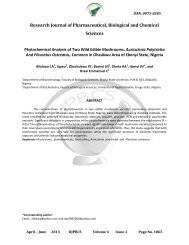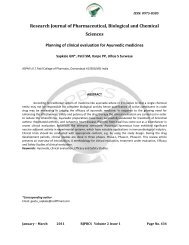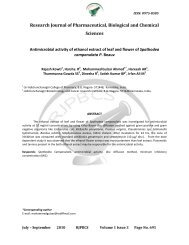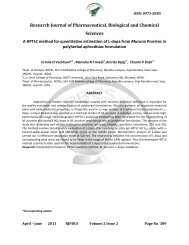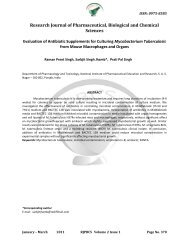Chitosan nanoparticles as a drug delivery system - research journal ...
Chitosan nanoparticles as a drug delivery system - research journal ...
Chitosan nanoparticles as a drug delivery system - research journal ...
You also want an ePaper? Increase the reach of your titles
YUMPU automatically turns print PDFs into web optimized ePapers that Google loves.
ISSN: 0975-8585<br />
Research Journal of Pharmaceutical, Biological and Chemical<br />
Sciences<br />
<strong>Chitosan</strong> <strong>nanoparticles</strong> <strong>as</strong> a <strong>drug</strong> <strong>delivery</strong> <strong>system</strong><br />
Osmania University, Hyderabad, Andhra Pradesh, India.<br />
A Krishna Sailaja * , P Amareshwar, P Chakravarty<br />
ABSTRACT<br />
<strong>Chitosan</strong> is a natural polymer obtained by deacetylation of chitin. After cellulose chitin is the second most<br />
abundant polysaccharide in nature. It is biologically safe,non-toxic,biocompatible and biodegradable<br />
polysaccharide.<strong>Chitosan</strong> <strong>nanoparticles</strong> have gained more attention <strong>as</strong> <strong>drug</strong> <strong>delivery</strong> carriers because of their better<br />
stability, low toxicity, simple and mild preparation method and providing versatile routes of administration. Their<br />
sub-micron size is also suitable for mucosal routes of administration i.e. oral, n<strong>as</strong>al and ocular mucosa which is<br />
non-inv<strong>as</strong>ive route.<strong>Chitosan</strong> <strong>nanoparticles</strong> showed to be a good adjuvant for vaccine. Therefore, the objectives of<br />
this review are to summarize the available preparation techniques and to discuss various applications of chitosan.<br />
Keywords: Nanoparticles, Drug <strong>delivery</strong> carriers, polymers<br />
*Corresponding author<br />
E-mail:- shailaja1234@rediffmail.com<br />
July – September 2010 RJPBCS Volume 1 Issue 3 Page No. 474
INTRODUCTION<br />
ISSN: 0975-8585<br />
The efficacy of many <strong>drug</strong>s is often limited by their potential to reach the site of<br />
therapeutic action. In most c<strong>as</strong>es only a small amount of administered dose reaches the target<br />
site, while the majority of the <strong>drug</strong> distributes through out the rest of the body in accordance<br />
with its physicochemical and biological properties. Therefore developing a <strong>drug</strong> <strong>delivery</strong> <strong>system</strong><br />
that optimizes the pharmaceutical action of <strong>drug</strong> while reducing its toxic side effects invivo is a<br />
challenging risk. One of the approaches is the use of colloidal <strong>drug</strong> carriers that can provide site<br />
specific or targeted <strong>drug</strong> <strong>delivery</strong> combined with optimal <strong>drug</strong> rele<strong>as</strong>e profiles. Among these<br />
carriers liposomes and <strong>nanoparticles</strong> have been the most extensively investigated. Liposomes<br />
present some technological limitations including poor reproducibility and stability, low <strong>drug</strong><br />
entrapment efficiency. Polymeric <strong>nanoparticles</strong> which posses a better reproducibility and<br />
stability profiles than liposomes have been proposed <strong>as</strong> alternative <strong>drug</strong> carriers that overcome<br />
many of these problems. Nanoparticles are solid colloidal particles with diameters ranging from<br />
1- 1000nm.They consist of <strong>drug</strong> carriers in which the active ingredient is dissolved, dispersed,<br />
entrapped, encapsulated, adsorbed or chemically attached. Polymers used to form<br />
<strong>nanoparticles</strong> can be both synthetic and natural polymers. Most of the polymers prepared from<br />
water insoluble polymers are involved heat,organic solvent or high shear force that can be<br />
harmful to the <strong>drug</strong> stability. Moreover, some preparation methods such a emulsion<br />
polymerization and solvent evaporation are complex and require a number of preparation steps<br />
that are more time and energy consuming. In contr<strong>as</strong>t, water soluble polymers offer mild and<br />
simple preparation methods without the use of organic solvent and high shear force. Among<br />
water soluble polymers available chitosan is one of the most extensively studied. This is<br />
because chitosan posses some ideal properties of polymeric carriers for <strong>nanoparticles</strong> such <strong>as</strong><br />
biocompatible, biodegradable, nontoxic and inexpensive. Furthermore it posses positively<br />
charge and exhibits absorption enhancing effect. These properties render chitosan a very<br />
attractive material <strong>as</strong> a <strong>drug</strong> <strong>delivery</strong> carrier. In the l<strong>as</strong>t two decades, <strong>Chitosan</strong> <strong>nanoparticles</strong><br />
have been extensively developed and explored for pharmaceutical application [1-3].<br />
<strong>Chitosan</strong><br />
<strong>Chitosan</strong> is a modified natural carbohydrate polymer prepared by the partial Ndeacetylation<br />
of chitin, a natural biopolymer derived from crustacean shells such <strong>as</strong><br />
crabs,shrimps and lobsters. <strong>Chitosan</strong> is also found in some microorganisms, ye<strong>as</strong>t and fungi<br />
(Illum, 1998). The primary unit in the chitin polymer is 2-deoxy-2-(acetylamino) glucose. These<br />
units combined by �-(1,4) glycosidic linkages, forming a long chain linear polymer. Although<br />
chitin is insoluble in most solvents, chitosan is soluble in most organic acidic solutions at pH less<br />
than 6.5 including formic, acetic, tartaric it is insoluble in phosphoric and sulfuric acid [4,5].<br />
July – September 2010 RJPBCS Volume 1 Issue 3 Page No. 475
STRUCTURAL FORMULA & PREPARATION OF CHITIN & CHITOSAN<br />
ISSN: 0975-8585<br />
Chitin is similar to cellulose both in chemical structure and in biological function <strong>as</strong> a<br />
structural polymer. The crystalline structure of chitin h<strong>as</strong> been shown to be similar to cellulose<br />
in the arrangements of inter- and intrachain hydrogen bonding (Figure 1). <strong>Chitosan</strong> is made by<br />
alkaline N-deacetylation of chitin. The term chitosan does not refer to a uniquely defined<br />
compound; it merely refers to a family of copolymers with various fractions of acetylated units.<br />
July – September 2010 RJPBCS Volume 1 Issue 3 Page No. 476
ISSN: 0975-8585<br />
It consists of two types of monomers; chitin-monomers and chitosan-monomers. Chitin is a<br />
linear polysaccharide consisting of (1-4)-linked 2-acetamido-2-deoxy-b-D-glucopyranose.<br />
<strong>Chitosan</strong> is a linear polysaccharide consisting of (1-4)-linked 2-amino-2-deoxy-b-Dglucopyranose.Commercial<br />
chitin and chitosan consists of both types of monomers. <strong>Chitosan</strong> is<br />
found in nature, to a lesser extent than chitin, in the cell walls of fungi. Chitin is believed to be<br />
the second most abundant biomaterial after cellulose. The annual biosynthesis of chitin h<strong>as</strong><br />
been estimated to 109 to 1011 tons. Chitin is widely distributed in nature. Among several<br />
sources, the exoskeleton of crustaceans consist of 15% to 20 % chitin of dry weight. Chitin<br />
found in nature is a renewable bioresource [6,7].<br />
PRODUCT CHARACTERIZATION<br />
<strong>Chitosan</strong> can be described in general by the following parameters:<br />
1)degree of deacetylation in %, 2)dry matter in %, 3)<strong>as</strong>h in %, 4)protein in %, 5)viscosity in<br />
Centipoise, 6)intrinsic viscosity in ml/g, 7)molecular weight in g/mol, 8)turbidity in NTU units.<br />
All of these parameters can be adjusted to the application for which chitosan is being used. The<br />
deacetylation is very important to get a soluble product. In general, the solubility of<br />
heteroglucans are also influenced by the distribution of the acetyl groups, the polarity and size<br />
of the monomers, distribution of the monomers along the chain, the flexibility of the chain,<br />
branching, charge density, and molecular weight (50,000 to 2,000,000 Da) of the polymer.<br />
Viscosity (10 to 5000 cp) can be adjusted to each application by controlling the process<br />
parameters [8].<br />
SPECIFICATIONS & CHARACTERISTICS OF PHARMACEUTICAL-GRADE CHITOSAN<br />
The pharmaceutical requirements for chitosan include: a white or yellow appearance<br />
(powder or flake), particle size < 30 m, density between 1.35 and 1.40 g/cm3, a pH of 6.5 to 7.5,<br />
moisture content < 10%, residue on ignition
ISSN: 0975-8585<br />
<strong>as</strong>sociated with chitosan via electrostatic interaction, hydrogen bonding, and hydrophobic<br />
interaction [9].<br />
Criteria for ideal polymeric carriers for <strong>nanoparticles</strong> & nanoparticle <strong>delivery</strong> <strong>system</strong>s are given<br />
below.<br />
Polymeric carriers<br />
E<strong>as</strong>y to synthesize and characterize<br />
Inexpensive<br />
Biocompatible<br />
Biodegradable<br />
Non-immunogenic<br />
Non-toxic<br />
Water soluble<br />
Nanoparticle <strong>delivery</strong> <strong>system</strong>s<br />
Simple and inexpensive to manufacture and scale-up<br />
No heat, high shear forces or organic solvents involved in their preparation process<br />
Reproducible and stable<br />
Applicable to a broad category of <strong>drug</strong>s; small molecules, proteins and polynucleotides<br />
Ability to lyophilize<br />
Stable after administration<br />
Non-toxic<br />
Ionotropic gelation<br />
<strong>Chitosan</strong> NP prepared by ionotropic gelation technique w<strong>as</strong> first reported by Calvo et al<br />
and h<strong>as</strong> been widely examined and developed. The mechanism of chitosan NP formation is<br />
b<strong>as</strong>ed on electrostatic interaction between amine group of chitosan and negatively charge<br />
group of polyanion such <strong>as</strong> tripolyphosphate. This technique offers a simple and mild<br />
preparation method in the aqueous environment. First, chitosan can be dissolved in acetic acid<br />
in the absence or presence of stabilizing agent, such <strong>as</strong> poloxamer, which can be added in the<br />
chitosan solution before or after the addition of polyanion. Polyanion or anionic polymers w<strong>as</strong><br />
then added and <strong>nanoparticles</strong> were spontaneously formed under mechanical stirring at room<br />
temperature. The size and surface charge of particles can be modified by varying the ratio of<br />
chitosan and stabilizer.<br />
Microemulsion method<br />
<strong>Chitosan</strong> NP prepared by microemulsion technique w<strong>as</strong> first developed by Maitra et al.<br />
This technique is b<strong>as</strong>ed on formation of chitosan NP in the aqueous core of reverse micellar<br />
droplets and subsequently cross-linked through glutaraldehyde. In this method, a surfactant<br />
July – September 2010 RJPBCS Volume 1 Issue 3 Page No. 478
ISSN: 0975-8585<br />
w<strong>as</strong> dissolved in N-hexane. Then, chitosan in acetic solution and glutaraldehyde were added to<br />
surfactant/hexane mixture under continuous stirring at room temperature. Nanoparticles were<br />
formed in the presence of surfactant. The <strong>system</strong> w<strong>as</strong> stirred overnight to complete the crosslinking<br />
process, which the free amine group of chitosan conjugates with glutaraldehyde. The<br />
organic solvent is then removed by evaporation under low pressure. The yields obtained were<br />
the cross-linked chitosan NP and excess surfactant. The excess surfactant w<strong>as</strong> then removed by<br />
precipitate with CaCl2 and then the precipitant w<strong>as</strong> removed by centrifugation. The final<br />
<strong>nanoparticles</strong> suspension w<strong>as</strong> dialyzed before lyophilyzation. This technique offers a narrow<br />
size distribution of less than 100 nm and the particle size can be controlled by varying the<br />
amount of glutaraldehyde that alter the degree of cross-linking. Nevertheless, some<br />
disadvantages exist such <strong>as</strong> the use of organic solvent, time-consuming preparation process,<br />
and complexity in the w<strong>as</strong>hing step.<br />
Emulsification solvent diffusion method<br />
El-Shabouri reported chitosan NP prepared by emulsion solvent diffusion method,<br />
(which originally developed by Niwa et al.employing PLGA. This method is b<strong>as</strong>ed on the partial<br />
miscibility of an organic solvent with water. An o/w emulsion is obtained upon injection an<br />
organic ph<strong>as</strong>e into chitosan solution containing a stabilizing agent (i.e. poloxamer) under<br />
mechanical stirring, followed by high pressure homogenization. The emulsion is then diluted<br />
with a large amount of water to overcome organic solvent miscibility in water. Polymer<br />
precipitation occurs <strong>as</strong> a result of the diffusion of organic solvent into water, leading to the<br />
formation of <strong>nanoparticles</strong>. This method is suitable for hydrophobic <strong>drug</strong> and showed high<br />
percentage of <strong>drug</strong> entrapment. The major drawbacks of this method include harsh processing<br />
conditions (e.g., the use of organic solvents) and the high shear forces used during nanoparticle<br />
preparation.<br />
Polyelectrolyte complex (PEC)<br />
Polyelectrolyte complex or self <strong>as</strong>semble polyelectrolyte is a term to describe complexes<br />
formed by self-<strong>as</strong>sembly of the cationic charged polymer and pl<strong>as</strong>mid DNA. Mechanism of PEC<br />
formation involves charge neutralization between cationic polymer and DNA leading to a fall in<br />
hydrophilicity. Several cationic polymers (i.e. gelatin, polyethylenimine) also possess this<br />
property. Generally, this technique offers simple and mild preparation method without harsh<br />
conditions involved. The <strong>nanoparticles</strong> spontaneously formed after addition of DNA solution<br />
into chitosan dissolved in acetic acid solution, under mechanical stirring at or under room<br />
temperature. The complexes size can be varied from 50 nm to 700 nm.<br />
Applications of chitosan <strong>nanoparticles</strong><br />
Parenteral administration<br />
Nano-sized particles can be administered intravenously because the diameter of the<br />
smallest blood capillary is approximately 4 µm. Particles greater than 100 nm in diameter are<br />
July – September 2010 RJPBCS Volume 1 Issue 3 Page No. 479
ISSN: 0975-8585<br />
rapidly taken up by the reticuloendothelial <strong>system</strong> (RES) in the liver, spleen, lung and bone<br />
marrow, while smaller-sized particles tend to have a prolonged circulation time. Negativelycharged<br />
particles are eliminated f<strong>as</strong>ter than positively-charged or neutral particles. In general,<br />
opsonins (serum proteins that bind to substrates leading to their being taken up by the RES)<br />
prefer to adsorb on hydrophobic rather than hydrophilic surfaces. The creation of a hydrophilic<br />
coating (such <strong>as</strong> polyethylene glycol (PEG) or a nonionic surfactant) on hydrophobic carriers<br />
significantly improves their circulation time. Together, these data suggest that generating<br />
<strong>nanoparticles</strong> with a hydrophlilic but neutral surface charge is a viable approach to reduce<br />
macrophage phagocytosis and thereby improve the therapeutic efficacy of loaded <strong>drug</strong><br />
particles.The most promising <strong>drug</strong>s that have been extensively studied for <strong>delivery</strong> by this route<br />
are anticancer agents. Following intravenous injection, many nanoparticle <strong>system</strong>s including<br />
chitosan NP exhibited a marked tendency to accumulate in a number of tumors. One possible<br />
re<strong>as</strong>on for the phenomenon may involve the leakiness of tumor v<strong>as</strong>culature. Doxorubicin<br />
loaded chitosan NP showed regression in tumor growth and enhance survival rate of tumorimplanted<br />
rats after IV administration. In addition, chitosan NP less than 100 nm in size have<br />
been developed which showed to be RES evading and circulate in the blood for considerable<br />
amount of time. Delivery of anti-infectives such <strong>as</strong> antibacterial, antiviral, antifungal and<br />
antipar<strong>as</strong>itic <strong>drug</strong>s, is another common use of <strong>nanoparticles</strong> [10]. The low therapeutic index of<br />
antifungal <strong>drug</strong>s, short half-life of antivirals and the limited ability of antibiotics to penetrate<br />
infected cells in intracellular compartments make them ideal candidates for nanoparticle<br />
<strong>delivery</strong>. Thus, it h<strong>as</strong> been suggested that <strong>nanoparticles</strong> should improve the therapeutic efficacy<br />
while decre<strong>as</strong>ing the toxic side effects of these <strong>drug</strong>s. In theory, chitosan NP are very attractive<br />
carrier <strong>system</strong> for these <strong>drug</strong>s <strong>as</strong> they offer many advantages such <strong>as</strong> hydrophilic surface<br />
particles, nano-size of less than 100 nm [11,12].<br />
Peroral administration<br />
The idea that <strong>nanoparticles</strong> might protect labile <strong>drug</strong>s from enzymatic degradation in<br />
the g<strong>as</strong>trointestinal tract (GIT) leads to the development of <strong>nanoparticles</strong> <strong>as</strong> oral <strong>delivery</strong><br />
<strong>system</strong>s for macromolecules, proteins and polynucleotides.Among polymeric <strong>nanoparticles</strong>,<br />
chitosan NP showed to be attractive carriers for oral <strong>delivery</strong> vehicle <strong>as</strong> they promote<br />
absorption of <strong>drug</strong>. The mucoadhesive properties of chitosan are due to an interaction between<br />
positively charged chitosan and negatively charge of mucin which provide a prolonged contact<br />
time between the <strong>drug</strong> and the absorptive surface, and thereby promoting the absorption.<br />
<strong>Chitosan</strong> mucoadhesion is also supported by the evidence that chitosan incre<strong>as</strong>es significantly<br />
the half time of its clearance. Furthermore, in vitro studies in Caco-2 cells have shown that<br />
chitosan is able to induce a transient opening of tight junctions thus incre<strong>as</strong>ing membrane<br />
permeability particularly to polar <strong>drug</strong>s, including peptides and proteins. Recent studies have<br />
shown that only protonated soluble chitosan, in its uncoiled configuration, can trigger the<br />
opening of the tight junctions, thereby, facilitating the paracellular transport of hydrophilic<br />
compounds. This property implies that chitosan would be effective <strong>as</strong> an absorption enhancer<br />
only in a limited area of the intestinal lumen where the pH values are below or close to its pKa.<br />
Although chitosan w<strong>as</strong> able to open up the tight junctions, the uptake of particle > 50 nm could<br />
not be explained by a widening of the intercellular spaces. Mechanism of chitosan NP transport<br />
July – September 2010 RJPBCS Volume 1 Issue 3 Page No. 480
ISSN: 0975-8585<br />
across GIT is most probably through adsorptive endocytosis. Electrostatic interaction between<br />
positively charged chitosan and negatively charged sialic acid of mucin causes <strong>as</strong>sociation of<br />
chitosan NP to the mucus layer and subsequently internalization via endocytosis. <strong>Chitosan</strong> NP<br />
internalization w<strong>as</strong> found to be higher in the jejunum and ileum than in duodenum.The ability<br />
of chitosan to enhance hydrophilic compounds transport across mucosal epithelial membrane<br />
depends on the chemical compositions and molecular weights of chitosan. A high degree of<br />
deacetylation (>65%) and/or high molecular weights appears to be necessary to incre<strong>as</strong>e<br />
epithelial permeability [13]. Pan et al. reported that hypoglycemic effect w<strong>as</strong> observed in<br />
induced diabetic rats after orally administration of chitosan <strong>nanoparticles</strong>. Furthermore,<br />
chitosan can be employed <strong>as</strong> a coating material for liposomes, micro/nanocapsules to enhance<br />
their residence time, thereby improving <strong>drug</strong> bioavailability. In addition to being used <strong>as</strong> an oral<br />
<strong>delivery</strong> carrier, chitosan NP could also be applied to other mucous membrane <strong>system</strong>s.<br />
Pulmonary and n<strong>as</strong>al routes are considered <strong>as</strong> promising routes to deliver peptides and<br />
proteins since they possess very large surface are<strong>as</strong> and manifest less intracellular and<br />
extracellular enzymatic degradation. Thus, n<strong>as</strong>al <strong>drug</strong> <strong>delivery</strong> may not need protection against<br />
enzymatic degradation by formulating <strong>as</strong> <strong>nanoparticles</strong> <strong>as</strong> oral <strong>drug</strong> <strong>delivery</strong>. It may be<br />
administered <strong>as</strong> solution or powder with absorption enhancing agent to slow down mucociliary<br />
clearance process and thereby prolong the contact time between the formulation and n<strong>as</strong>al<br />
tissue. Recently, chitosan w<strong>as</strong> demonstrated to promote the n<strong>as</strong>al absorption of insulin in rats<br />
and sheep. However, the insulin-chitosan powder, chitosan blended with insulin using pestle<br />
and mortar, showed to have bioavailability greater than chitosan NP containing insulin [14-17].<br />
Non-viral gene <strong>delivery</strong> vectors<br />
Although viruses can efficiently transfer genes into cells, concerns such <strong>as</strong> host immune<br />
response, residual pathogenicity, and potential induction of neopl<strong>as</strong>tic growth following<br />
insertional mutagenesis have led to the exploration of non-viral gene transfer <strong>system</strong>s. These<br />
latter <strong>delivery</strong> <strong>system</strong>s are generally considered to be safer since they are typically less<br />
immunogenic and lack mutational potential. There are usually considered to be five primary<br />
barriers that must be overcome for successful gene <strong>delivery</strong>: in vivo stability, cell entry,<br />
endosome escape, intracellular trafficking and nuclear entry. Cationic polymers and lipids have<br />
both shown promise <strong>as</strong> gene <strong>delivery</strong> agents since their polycationic nature produces particles<br />
that reduce one or more of these barriers. For example, by collapsing DNA into particles of<br />
reduced negative or incre<strong>as</strong>ed positive charge, binding to the cell surface and enhanced<br />
endocytosis may be promoted. In many c<strong>as</strong>es, cationic polymers seem to produce more stable<br />
complexes thus offering more protection during cellular trafficking than cationic lipids [18].<br />
<strong>Chitosan</strong> is a cationic polymer with extremely low toxicity. It showed significantly lower<br />
toxicity than poly-L-lysine and PEI. Additionally, it enhances the transport of <strong>drug</strong> across cell<br />
membrane <strong>as</strong> discussed earlier. <strong>Chitosan</strong> <strong>as</strong> a promising gene <strong>delivery</strong> vector w<strong>as</strong> first proposed<br />
by Mumper [19-20]. <strong>Chitosan</strong> mediates efficient in vitro gene transfer at nitrogen to phosphate<br />
(N/P) ratio of 3 and 5. At these ratios, small chitosan-DNA complexes can be prepared in the<br />
range of 50-100 nm with a positively surface charge of approximately +30 mV. Sato et al. found<br />
that in vitro chitosan-mediated transfection depends on the cell type, serum concentration, pH<br />
July – September 2010 RJPBCS Volume 1 Issue 3 Page No. 481
ISSN: 0975-8585<br />
and molecular weight of chitosan. Hela cells were efficiently transfected by this <strong>system</strong> even in<br />
the presence of 10% serum. In contr<strong>as</strong>t, chitosan have not been able to transfect HepG2 human<br />
hepatoma cells and BNL CL2 murine hepatocytes. The transfection efficiency w<strong>as</strong> found to be<br />
higher at pH 6.9 than that at pH 7.6. This can be explained by that at below pH 7, amine groups<br />
of chitosan are protonated which facilitate the binding between complexes and negatively<br />
charged cell surface. Transfection efficiency meditated by chitosan of high molecular weight,<br />
>100 kDa, is less than that of low molecular weight, 15 and 52 kDa. Although chitosan<br />
successfully transfected cells in vitro, the transfection efficiency showed to be lower than that<br />
of other cationic polymer vehicles such <strong>as</strong> polyethylenimine. This leads to developing of<br />
chitosan NP <strong>system</strong> to incre<strong>as</strong>e transfection efficiency. So far, two approaches have been<br />
developed. First, by incre<strong>as</strong>ing chitosan solubility <strong>as</strong> it is well known that only soluble<br />
protonated chitosan can cause transient opening of tight junctions.Therefore, trimethyl<br />
chitosan (TMC), quaterinzed chitosan, w<strong>as</strong> proposed by GuangLiu et al. <strong>as</strong> a vehicle that<br />
promoting transmembrane transport of gene by possessing better solubility than chitosan. The<br />
results showed that this vector provided transfection efficiency greater than chitosan and<br />
proved to be nontoxic. Another approach is attachment of cell targeting ligands to the chitosan<br />
particles. Park et al. developed liver targeted <strong>delivery</strong> <strong>system</strong> by preparing galactosylatedchitosan-graft-dextran<br />
DNA complexes, <strong>as</strong> galactose is known <strong>as</strong> liver targeted <strong>delivery</strong>.<br />
Similarly, Mao et al. prepared transferrin-chitosan-DNA <strong>nanoparticles</strong> <strong>as</strong> a targeted <strong>drug</strong><br />
<strong>delivery</strong>. Transferrin can be taken up by receptor-mediated endocytosis mechanism <strong>as</strong><br />
transferrin receptor found on many mammalian cells. Unfortunately, they showed transfection<br />
efficiency less than expected. However, when KNOB (C-terminal globular domain of fiber<br />
protein) conjugated to the chitosan, the transfection efficiency in Hela cells can be improved by<br />
130 fold. The mechanism of cationic polymer-mediated have been investigated but still<br />
remained unclear [21].<br />
Ocular administration<br />
Among mucoadhesive polymers explored now, chitosan h<strong>as</strong> attracted a great deal of<br />
attention <strong>as</strong> an ophthalmic <strong>drug</strong> <strong>delivery</strong> carrier because of its absorption promoting effect.<br />
<strong>Chitosan</strong> not only enhance cornea contact time through its mucoadhesion mediated by<br />
electrostatic interaction between its positively charged and mucin negatively charged, its ability<br />
to transient opening tight junction is believed to improve <strong>drug</strong> bioavailability [22]. Felt et al.<br />
found that chitosan solutions prolonged the cornea resident time of antibiotic in rabbits. The<br />
same effects were also observed employing chitosan NP <strong>as</strong> demonstrated by De Campos et al.<br />
that chitosan NP remained attached to the rabbits’ cornea and conjunctiva for at le<strong>as</strong>t 24 hr. In<br />
addition, De Campos et al. found that after ocular administration of chitosan NP in rabbits,<br />
most of <strong>drug</strong> were found in extraocular tissue, cornea and conjunctiva, while negligible <strong>drug</strong><br />
were found in intraocular tissues, iris/ciliary body and aqueous humor. Together, these results<br />
suggested that chitosan NP showed to be attractive material for ocular <strong>drug</strong> <strong>delivery</strong> vehicle<br />
with potential application at extraocular level [23-23].<br />
July – September 2010 RJPBCS Volume 1 Issue 3 Page No. 482
Delivery of vaccines<br />
ISSN: 0975-8585<br />
Nanoparticles often exhibit significant adjuvant effects in parenteral vaccine <strong>delivery</strong><br />
since they may be readily taken up by antigent presenting cells. The submicron size of<br />
<strong>nanoparticles</strong> allows them to be taken up by M-cells, in mucosa <strong>as</strong>sociated lymphoid tisSue<br />
(MALT) i.e. gut-<strong>as</strong>sociated, n<strong>as</strong>al-<strong>as</strong>sociated and bronchus-<strong>as</strong>sociated lymphoid tissue, initiating<br />
sites of vigorous immunological responses. Immunoglobulin A (IgA), a major immunoglobulin at<br />
mucosal surface, and the generation of B-cell expressing IgA occur primarily in MALT. The B-cell<br />
then leave the MALT and reach <strong>system</strong>ic circulation where they clonally expand and mature<br />
into IgA pl<strong>as</strong>ma cells. Therefore, providing not only protective IgA at the pathogen entered<br />
sites, but also <strong>system</strong>ic immunity. There are two main administration routes for mucosal<br />
vaccine <strong>delivery</strong>, oral and n<strong>as</strong>al [25]. The main targeted for oral <strong>delivery</strong> vaccine are Peyer’s<br />
patches. By incorporating vaccine into <strong>nanoparticles</strong> <strong>system</strong>s, the vaccine is protected against<br />
enzymatic degradation on its way to the mucosal tissue and efficiently taken up by M-cells. In<br />
contr<strong>as</strong>t to oral administration, n<strong>as</strong>al administered vaccines have to be transported over a very<br />
small distance, remain only about 15 minutes in the n<strong>as</strong>al cavity, and are not exposed to low pH<br />
values and degradative enzymes. Thus, n<strong>as</strong>al <strong>delivery</strong> vaccines may not necessary formulated <strong>as</strong><br />
<strong>nanoparticles</strong> <strong>as</strong> discussed earlier. It may be administered <strong>as</strong> solution or powder with<br />
absorption enhancing agent to slow down mucociliary clearance process and thereby prolong<br />
the contact time between the formulation and n<strong>as</strong>al tissue. Among the polymers used to form<br />
vaccine <strong>nanoparticles</strong>, chitosan is one of the most recently explored and extensively studied <strong>as</strong><br />
prospective vaccine carriers. Its absorption promoting effect is believed to improve mucosal<br />
immune response. Illum et al. successfully developed chitosan vaccines containing influenza,<br />
pertussis and diphtheria antigens for n<strong>as</strong>al <strong>delivery</strong>. They demonstrated that these vaccines<br />
produced a significant antibody level in mice, both serum and secretory IgA. Despite the<br />
potential carrier for mucosal <strong>delivery</strong> vaccine, chitosan h<strong>as</strong> also been reported to act <strong>as</strong> an<br />
adjuvant for <strong>system</strong>ic vaccine <strong>delivery</strong> such <strong>as</strong> incre<strong>as</strong>ing the accumulation and activation of<br />
macropharges and polymorphonuclear cells. Activation of macropharges is initiated after<br />
uptake of chitosan. Furthermore, chitosan h<strong>as</strong> also been widely explored <strong>as</strong> the application for<br />
DNA mucosal vaccines. For instance, a chitosan-b<strong>as</strong>ed DNA flu vaccine h<strong>as</strong> been developed. This<br />
<strong>system</strong> showed high antibody level in mice after intran<strong>as</strong>al administration [26-28].<br />
REFERENCES<br />
[1] Illum, L. Pharm. Res 1998;15:1326-1331.<br />
[2] Kreuter, J. Nanoparticles. In: Colloidal Drug Delivery Systems, edited by Kreuter, J.<br />
New York: Marcel Dekker, 1994; 261-276.<br />
[3] Mueller, R. H. Colloidal Carriers for Controlled Drug Delivery and Targeting,<br />
Boston: CRC Press, 1991,379 p.<br />
[4] Hoppe-Seiler F. Ber Dtsch Chem Ges. 1994; 27:3329-3331.<br />
[5] Roberts GAF. Solubility and solution behaviour of chitin and chitosan. In: Roberts<br />
GAF, ed. Chitin Chemistry. MacMillan, Houndmills. 1992:274-329.<br />
July – September 2010 RJPBCS Volume 1 Issue 3 Page No. 483
ISSN: 0975-8585<br />
[6] Muzzarelli RAA, Bald<strong>as</strong>sare V, Conti F, Gazzanelli G, V<strong>as</strong>i V, Ferrara P, Biagini G.<br />
Biomaterials 1988;8:247-252.<br />
[7] Miyazaki S, Ishii K, Nadai T. Chem Pharm Bull 1981;29:3067-3069.<br />
[8] Kurita K. Chemical modifications of chitin and chitosan. In: Muzzarelli RAA,<br />
Jeuniaux C, Gooday GW, eds. Chitin in Nature and Technology. Plenum: New York,<br />
NY. 1986:287- 293.<br />
[9] Roberts GAF. Structure of chitin and chitosan.In:Roberts GAF,ed,Chitin<br />
chemistry.Mac Millan, Houndmills. 1992: 1-53.<br />
[10] Allemann, ER Gurny and E Doelker. Eur J Pharm Biopharm 1993;39: 173-191.<br />
[11] Janes KA, MP Fresneau, A Marazuela, A Fabra and MJ Alonso. J Control Rele<strong>as</strong>e<br />
2001; 73:255-267.<br />
[12] Gerlowski LE and RK Jain. Microv<strong>as</strong>c Res 1986;31: 288-305.<br />
[13] Bender ARH, Von Briesen J, Kreuter IB, Duncan and H Rubsamen-Waigmann.<br />
Antimicrob Agents Chemother 1996;40: 1467 1471.<br />
[14] Luessen HL, BJ de Leeuw, MW Langemeyer AB. de Boer, JC Verhoef and HE<br />
Junginger. Pharm Res 1996; 13: 1668-1672.<br />
[15] Norris GN, Puri and PJ Sinko. Adv Drug Deliv Rev 1998; 34: 135-154.<br />
[16] Lehr CM, Bouwstra JA, Schacht EH, Junginger HE. Int J Pharm 1992;78:43-48.<br />
[17] Fernandez-Urrusuno RP, Calvo C, Remunan-Lopez, JL Vila-Jato and MJ Alonso.<br />
Pharm Res 1999; 16: 1576-1581.<br />
[18] Dyer AM, M Hinchcliffe P, Watts J, C<strong>as</strong>tile I, Jabbal-Gill, R Nankervis, A Smith,<br />
and L Illum. Pharm Res 2002;19:998-1008.<br />
[19] Erbacher P, S Zou, AM Steffan, and JS Remy. Pharm Res 1998; 15: 1332-1339.<br />
[20] Guang Liu W and K De Yao. J Control Rele<strong>as</strong>e 2002; Vol. 83, pp. 1-11.<br />
[21] Lemkine GF and BA Demeneix. Curr Opin Mol Ther 2001; 3: 178-182.<br />
[22] Hirano S. Biotechnol Annu Rev 1996;2:237- 258.<br />
[23] De Campos AMA, Sanchez and MJ Alonso. Int J Pharm 2001 224: 159-168.<br />
[24] Felt O, P Furrer, JM, Mayer B, Plazonnet P, Buri and R Gurny. Int J Pharm.<br />
1999;180:185-193.<br />
[25] lonso MJ, Sanchez A. J Pharm Pharmacol 2003;55:1451-1463.<br />
[26] Illum LI, Jabbal-Gill, M Hinchcliffe, AN Fisher, and SS Davis. Adv Drug Deliv Rev<br />
2001; 51: 81-96.<br />
[27] Kreuter J, Chapter 19: Nanoparticles <strong>as</strong> adjuvants for vaccines. In:Vaccine Design,<br />
edited by Powell MF, and MJ Newman. New York: Plenum Press, 1995;463-471.<br />
[28] Van der Lubben IM, Kersten G, Fretz MM, Beuvery C, Coos Verhoef J, Junginger<br />
HE. Vaccine. 2003;28:1400-1408.<br />
July – September 2010 RJPBCS Volume 1 Issue 3 Page No. 484



